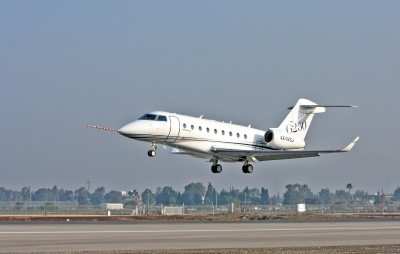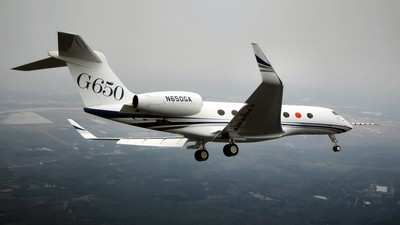G650 Production Is Increasing As Accident Investigation
Continues
Gulfstream's G250 is on schedule for certification later this
year, the company says, having recently completed several tests
required for it to receive its type certificate from the FAA, the
Civil Aviation Authority of Israel and the EASA. The three
flight-test aircraft have accumulated more than 1,150 flight hours
over more than 400 flights.

"We are on track and steadily moving toward certification this
year," said Mark Kohler, director, G250 program. "The aircraft is
performing exceptionally well."
Aircraft Number 2002, the second of three aircraft in the
flight-test program, successfully completed water ingestion testing
in late March in the United Kingdom. As required by Federal
Aviation Regulations, the tests confirmed that the aircraft's two
Honeywell HTF7250G engines, its auxiliary power unit and its
airspeed system will continue to operate normally even after
traveling through standing water.
The tests were conducted along a 5,902-foot runway during all
critical phases of takeoff, landing and taxi. The G250 performed
nine successful runs.
The third flight-test aircraft, Serial Number 2003, completed
the first phase of human factors testing at the company's
headquarters in Savannah last month. The testing included avionics
performance and flight-deck ergonomics. Each six-member crew flew
three flights: a day Visual Meteorological Conditions (VMC) flight,
a day Instrument Meteorological Conditions (IMC) flight and a night
VMC flight.

During human factors testing, each of the two-hour flights
begins as a normal flight. Human factors engineers then introduce
scenarios that force the crew to perform other tasks, including
potential abnormal and emergency procedures. At the end of each
flight, the crew completes a questionnaire, and the responses are
used to create a report for certification.
The second phase of human factors workload testing will include
representatives from each of the certification authorities. Results
from both phases will be submitted to the certification authorities
for certification credit.
To receive its type certificate, the G250 must finish the
remaining aircraft systems and field performance tests as well as a
portion of the more than 40,000 airframe fatigue cycles, which are
already under way at Israel Aerospace Industries. The aircraft have
completed static structural, limit/ultimate load, natural icing,
far-field noise and high-field elevation tests.
Back in Savannah, Gulfstream has begun manufacturing the 13th
Gulfstream G650 aircraft, as all production, engineering and
ground-test activities for the aircraft continue on pace, according
to company officials. The company is working closely with the FAA
to resume the flight-test activities required as part of the
aircraft's type certification.

As manufacturing continues, so, too, do other program
activities. The G650 fatigue test article (F6) is now in the
structural test hangar, where it will spend the next three years
"flying" the equivalent of two and a half life cycles to verify the
airframe's structural durability. Encased in a web of steel tubes,
wires, jacks and actuators, the airframe will experience conditions
similar to those encountered during 100,000 flying hours over
42,500 flights. A single life cycle is considered 40,000 hours and
17,000 landings.
The G650 flight-test aircraft have accumulated some 1,500 flight
hours in an estimated 2,200-hour certification program. The
aircraft have already completed a number of test points, including
airspeed calibration, flutter, power plant and auxiliary power unit
operations, flyover noise and water ingestion. Gulfstream
voluntarily suspended G650 flight testing April 2, following an
accident involving the second flight-test aircraft, Serial Number
6002. The accident is under investigation by the NTSB. Gulfstream
is fully cooperating in that investigation.

Preparations for the G650's 2012 entry into service are also on
track. The simulator that will be used to train and certify G650
pilots has been delivered to FlightSafety in Savannah. The
full-motion simulator is expected to receive Level D certification
from the FAA in 2012. Training time for pilot certification will
vary from 13 to 24 days, depending on the pilot's level of
experience with other Gulfstream aircraft.
 ANN's Daily Aero-Linx (04.15.24)
ANN's Daily Aero-Linx (04.15.24) Classic Aero-TV: 'No Other Options' -- The Israeli Air Force's Danny Shapira
Classic Aero-TV: 'No Other Options' -- The Israeli Air Force's Danny Shapira Aero-News: Quote of the Day (04.15.24)
Aero-News: Quote of the Day (04.15.24) Airborne 04.16.24: RV Update, Affordable Flying Expo, Diamond Lil
Airborne 04.16.24: RV Update, Affordable Flying Expo, Diamond Lil ANN's Daily Aero-Term (04.16.24): Chart Supplement US
ANN's Daily Aero-Term (04.16.24): Chart Supplement US






